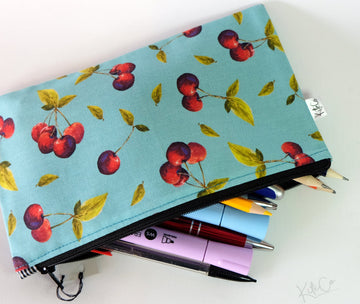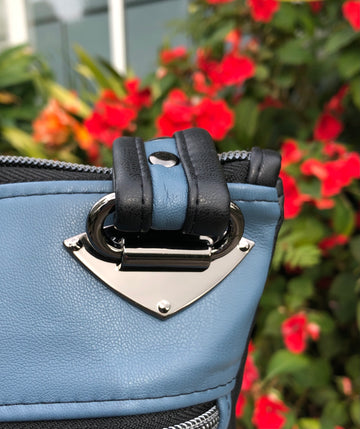Experiment Weekend! Meet HeatnBond Liquid Vinyl.
I have had quite a few questions and requests for this article lately, so I am republishing it as a blog post.
The first "Experiment" section was originally written as a series of Facebook posts over a weekend as I experimented with the product. And then collated together as an article/report sent out to my customers via email.
The second part I wrote after I had done some experimental sewing in response to some of the questions that were being asked.
I have also written a guide on how to use the product and you can access that here.
Application Experiment
Here is the transcript of my experimental weekend using HeatnBond. Taken from my Facebook Posts

As my email subscribers will know I bought 3 pots of this liquid vinyl to see what it can do.
It should create:
With 1 coat - water and stain resistant
With 2 coats, waterproof and stain-resistant
With 3 coats a cool glossy oil cloth effect.
The Test Begins
HeatnBond Liquid Vinyl Experiment Part 1
Preparation:
I cut 3 squares of two fabrics, each 14" square: coloured quilting weight cotton and houndstooth cotton. The quilting cotton felt slightly smoother than the houndstooth.
The instructions call for a smooth fabric, but I think that probably means nothing with a lot of texture, like knit etc.
The instructions also tell you to wash and dry the fabric before applying the liquid vinyl, (without fabric softener).
I have heard that Odicote can shrink the fabric slightly, so I decided to wash one square of each type of fabric and line-dry them.
You will see in the first picture some shrinkage, around 1/2"

Application
Next, I laid them out ready to go on non-stick baking paper.
(Note: Only use top-quality double-sided non-stick baking paper or you will have a mess).
I was too excited to notice that the washed pieces had frayed a little. This proved to be not so much a problem as a pain.
I used a soft bristled nylon all-purpose wall paintbrush. 50mm, so it just fitted into the jar.
With trepidation, I began.

Surprisingly the gel is really thick, so there are no drip problems, it also glides on really smoothly and easily and best of all a little goes a long way.
I used horizontal strokes overlapping each row with the next and using only enough to coat the fabric. Every 3-4 strokes I applied a little more to the far end.
Once coated I left it to dry for 40 minutes.
HeatnBond Liquid Vinyl Experiment Part 2
Time to cure the liquid vinyl by ironing.
You must iron it on a firm surface, not spongy like an ironing board. I put a silicone baking mat down on my granite benchtop with a Tea towel and baking paper on top.
It says to press for 45 seconds. I did each piece for around 3 mins, moving the iron very slowly. That seemed to work.

With the first coat applied and cured the fabric handles the same as if you had applied light to medium weight interfacing and has a slight sheen and definitely feels a little thicker.
You can see from the pictures that the drape has become very slightly stiffer. and from the closeup a faint glimmer is apparent. Edit: Treated fabric is on the left in all pictures.

Time to apply coat number 2.
HeatnBond Liquid Vinyl Experiment Part 3
Painting on the second coat is quicker and even easier Although I recommend trimming off any new fraying bits before you start. Even less product is required as it no longer has to sink into the fabric.
The results from the second coat are impressive. It's already beginning to look and feel a little like oilcloth.
So far, I am very happy

HeatnBond Liquid Vinyl Experiment Part 4
Well, I have to say that after the 3rd coat I am very impressed with the finished look.
I have to wait 24 hours for it to finish curing and then I can have a go at squirting ketchup on it and wetting it.
After that, I get to sew it into a project, and I think I know just the one to try it out....
Note on shrinkage.
Shrinkage after application on both the pre-washed and un-washed pieces was around ¼” on the 14” square. So best to treat the fabric with HeatnBond before cutting your pattern pieces.
Sewing with the Treated Fabric
I decided to sew 2 projects and chose the Starlight wallet and the Mighty Mini Phone bag. (Both are patterns by Dianne Spencer ogg.

Reasons:
The Starlight wallet offered the following sewing challenges and would be sewn on a domestic machine:
- Piping
- A wristlet strap which means the treated fabric would be touching both the bed of the machine and the bottom of the presser foot.
- A tabbed zipper, the foot would need to touch two different fabric types at once.
The mighty mini offered these challenges/tests and would be sewn on an industrial machine:
- Chunky enough layers to use on an industrial machine.
- I could mix, cotton lining, with the treated fabric and some soft buttery faux leather.
- The bag requires some reasonably hard turning, some parts twice.
How did the domestic machine do?
I sewed the Starlight Wallet on my domestic Juki HZLDX7.
Most of the sewing went quite smoothly. The zippers were no problem to attach and insert. Top-stitching next to the zip with a blind hem foot with the foot sitting half on half off the fabric also went well.
Things did get a little more “sticky” when it came to the piping and the wristlet.
I first did a test to see how the Juki went with the treated fabric both against the machine bed and under the foot. I sewed two strips together to make a seam then pressed and turned out to top stitch down each side of the seam.
This didn’t go so well as you can see from the uneven stitches on the right side of the seam in this picture. However, switching to a Teflon foot and putting baking paper underneath the fabric, completely solved the issue, see the left-hand side.

Piping
I cut a strip of the pink cotton lining on the bias (diagonal) and then treated it with the HeatnBond to see how it would perform.
Sewing in the piping cord was a little tricky, but by putting baking paper underneath again, I was able to use the piping foot.
When it came to inserting the piping, the HeatnBond definitely takes away some of the stretch that you would normally get with a diagonally cut bias strip, making the corners a little lumpier than usual. I would therefore recommend using untreated piping where possible.

Sewing the wristlet strap
I’d already done my test with the topstitching, so was prepared with the baking paper and Teflon foot. This worked OK, but the stitching was not as regular as I would have liked.
Next, I tried spraying the strap with CRC 808 silicone spray which is fabric-friendly. The result was perfect. This also works well on vinyl when nothing else does.

Sewing the Mighty Mini
Sewing the Mighty Mini on my industrial Zoje 303L was a breeze. It handled the treated fabric and the non-treated with absolutely no problems.
When it came to turning the bag, I was quite amazed. It came through perfectly. The flap uses Decovil which on some thinner vinyls will show every crease and crinkle, but in this case, it all turned out smoothly.


A note on Ironing and Interfacing. I interfaced the fabric with Shape to Create using wool setting and baking paper above and below. Then I allowed it to cool. Ironing and pressing can be done in the same way.
Conclusion:
I love this product. It’s easy to use and goes a long way. The end result is beautiful, and the feel is more like oil cloth than rubbery, which is nice.
When sewing on a domestic machine. Do some tests first as different machines react differently with vinyl and this product. However. It is perfectly possible to get a good result once you have experimented a bit.
I don’t personally make bags to sell, but if I did, I would have been very happy to sell either of these.
New Zealand readers, you can purchase HeatnBond here





